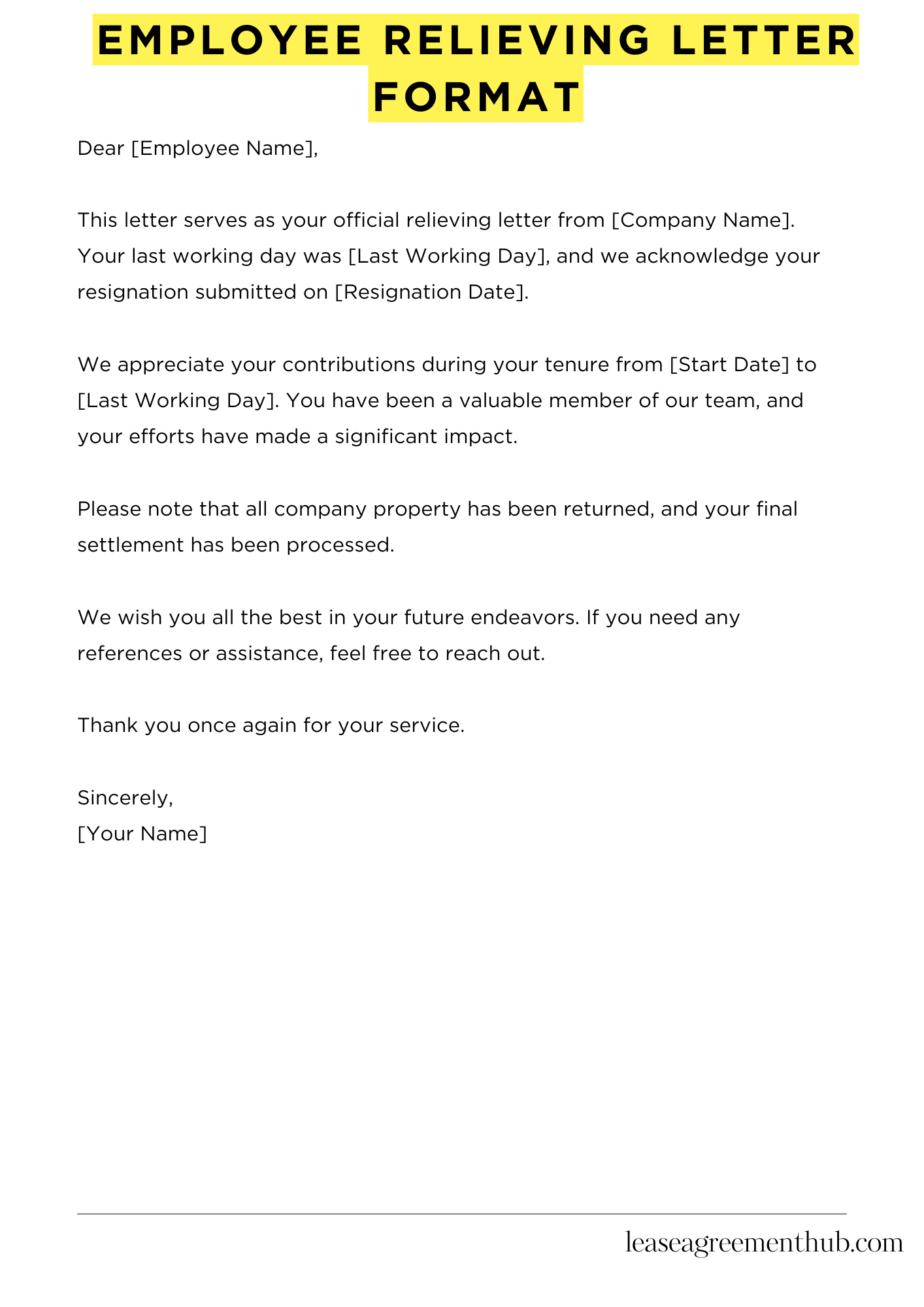An Employee Relieving Letter Format is a formal document issued by an employer to confirm that an employee has left the organization. It serves as proof of employment termination and outlines the employee’s last working day. This letter is important for the employee’s future job applications, as it verifies their tenure and conduct during their time at the company.
In this article, we will provide various templates and examples of Employee Relieving Letter Formats. These samples will help you craft your own letter quickly and easily. Whether you are an employer or an employee, you will find practical formats to suit your needs.
With our user-friendly templates, writing a relieving letter will become a hassle-free task. You can customize these samples to fit your unique situation. This way, you can ensure that your letter conveys the right message while maintaining a professional tone.
Employee Relieving Letter Format
[Your Company Letterhead]
[Company Name]
[Company Address]
[City, State, Zip Code]
[Email Address]
[Phone Number]
[Date]
[Employee Name]
[Employee Address]
[City, State, Zip Code]
Dear [Employee Name],
This letter serves as your official relieving letter from [Company Name]. Your last working day was [Last Working Day], and we acknowledge your resignation submitted on [Resignation Date].
We appreciate your contributions during your tenure from [Start Date] to [Last Working Day]. You have been a valuable member of our team, and your efforts have made a significant impact.
Please note that all company property has been returned, and your final settlement has been processed.
We wish you all the best in your future endeavors. If you need any references or assistance, feel free to reach out.
Thank you once again for your service.
Sincerely,
[Your Name]

How to Write Employee Relieving Letter Format
Understanding the Purpose of a Relieving Letter
A relieving letter is an important document that an employer provides to an employee who is leaving the organization. It serves as proof that the employee has officially resigned and has completed all necessary formalities. This letter is crucial for the employee’s future job applications, as it confirms their tenure and conduct during their time at the company.
Key Components of a Relieving Letter
When writing a relieving letter, there are several key components to include:
- Company Letterhead: Use the official letterhead of the organization.
- Date: Mention the date when the letter is being issued.
- Employee Details: Include the employee’s name, designation, and department.
- Statement of Relieving: Clearly state that the employee is relieved from their duties.
- Final Settlement: Mention any final settlements or dues, if applicable.
- Good Wishes: Offer best wishes for the employee’s future endeavors.
- Signature: Include the signature of the authorized person along with their designation.
Sample Format of a Relieving Letter
Here is a simple format you can follow when drafting a relieving letter:
[Company Letterhead] [Date] To, [Employee Name] [Employee Designation] [Department] Subject: Relieving Letter Dear [Employee Name], This is to formally acknowledge the receipt of your resignation letter dated [resignation date]. We confirm that you have been relieved from your duties as [Employee Designation] with effect from [last working day]. We appreciate your contributions during your tenure with us. All your dues have been settled, and you are free to pursue your future endeavors. We wish you all the best for your career ahead. Sincerely, [Your Name] [Your Designation]
Tips for Writing an Effective Relieving Letter
While writing a relieving letter, keep these tips in mind:
- Be clear and concise. Avoid unnecessary jargon.
- Maintain a professional tone throughout the letter.
- Ensure that all details are accurate and up to date.
- Review the letter for any grammatical or spelling errors.
Conclusion
Writing an employee relieving letter is a straightforward process, but it carries significant weight for both the employer and the employee. By following the proper format and including all necessary components, you can create a professional document that will serve its purpose effectively. Remember, a well-crafted relieving letter not only helps the employee transition smoothly but also reflects the organization’s professionalism.
Related: